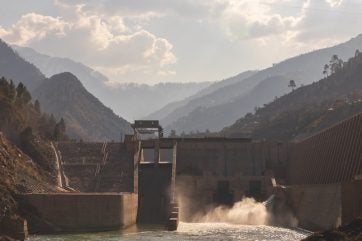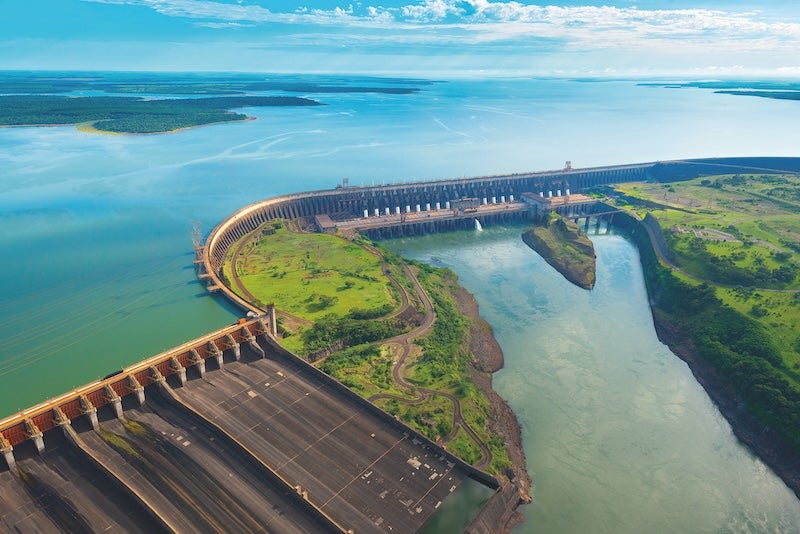
Despite its immense promise, Nepal has only achieved a fraction of its hydropower potential with over 50% of an estimated 83,000MW deemed as being feasible to develop. With the success or failure of power development often dependent upon favourable policy implementation, new research has sought to analyse the efficiency, effectiveness, and feasibility of Nepal’s existing Hydropower Development Policy (HDP) of 2001.
Representing 25 different sectors within the Nepalese hydropower industry, participants in the research were from various government departments such as the Ministry of Energy, Water Resources and Irrigation, the Ministry of Forest and Environment, Ministry of Land Management, Cooperatives, and Poverty Alleviation, as well as entities like the Nepal Electricity Authority, investment boards, journalists, and representatives from foreign direct investments.
In addition to assessing the adequacy of the HDP for strengthening the power sector, the research also sought to identify policy constraints and obstacles encountered by developers, uncovering new insights for formulating an investment conducive hydropower development policy.
While the overall perception of HDP 2001 was deemed as being ‘favourable’, in the past it has been described as being ‘outdated and inadequate’ which hampers its ability to address contemporary challenges.
In this recent research undertaken by Pradhan et al and published in The Journal of Shaheed Smarak College, concerns were expressed about differing aspects, such as mechanisms for wheeling charges, inadequate participation from the private sector, and delays in policy amendments. Substantial obstacles related to land acquisition, environmental evaluations, and policy execution were also highlighted, underscoring the need for prompt revisions to accommodate evolving socio-economic and environmental factors.
In conclusion, the researchers stated that while the HDP 2001 was generally perceived as being investment-friendly, addressing the identified challenges and revising policies in line with current realities will be essential to enable sustainable hydropower development in Nepal, thus allowing the country to harness its renewable energy potential.
EIA assessment for hydropower development
Investigating the structural limits of Environmental Impact Assessment (EIA) guidelines for hydropower development in Pakistan has also been the focus of another study undertaken by Qayyuum Butt et al, and published in Frontiers in Environmental Science.
Although an adequate mechanism is available, and donors like the Asian Development Bank and World Bank observe the implementation process of the EIA in Pakistan, the research found that several things that could be improved, not only in the institutional framework but also in the actual implementation and practices. Some respondents suggested that the existing guidelines followed in Pakistan are not aligned with international standards and practices for hydropower, while the EIA has a limited impact on decision-making due to insufficient technical and financial resources.
Complexity issues
A workshop held at the University of Bologna in Italy, recently focused on exploring the complexity and multifaceted nature of international law relevant to the development and operation of major hydropower infrastructure within shared transboundary basins. Topics covered included transboundary water resource management, environmental protection, climate change mitigation and adaptation, human rights protection, indigenous rights, cultural heritage protection, transnational governance, international investor protection, and international trade.
An insight was given into how various human rights frameworks such as the human right to safe drinking water and indigenous people’s rights, are relevant to hydropower development. Indeed there are various international law tools and mechanisms available, including river basin organisations and judicial bodies, which may help to reconcile tensions when the development of a hydropower project risks affecting the quantity or quality of water provided to local and vulnerable communities, including indigenous people. T
The binational entity of Itaipu between Brazil and Paraguay was also used as an example to show how riparian states with varying or contrary uses of shared water resources can cooperate in the management of resources, by utilising international water law’s principle of reasonable and equitable utilisation. This principle was employed to develop the concept of a “water window special operation,” aimed at addressing varying water uses in the basin and the principle was invoked as a customary rule of international water, even though the principle is not contained in any pertinent agreement between the parties.

Chinese investment
China is located upstream on most of the major transboundary waters shared with vast populations across Asia. Heavily invested in developing hydropower at home and abroad, it often involves freshwater crossing national borders and raises complex issues in international law. It’s also a situation that is exacerbated by growing economic, environmental, and regional security pressures.
An article by Wouters et al published in Frontiers in Climate examines the regulatory interface of relevant legal frameworks, with a focus on China’s approach to such transboundary developments. While international economic – and more specifically international investment law – is not directly concerned with international water law, host states and foreign investors must be informed, and take into account, the legal obligations governing transboundary waters. According to the authors, China’s position as a major water user (at home) and significant investor (abroad) on transboundary waters, makes it a unique case study for exploring the rules of international law,
In examining the interface of international water law and international investment law, in the context of hydropower development on transboundary watercourses by China at home and abroad, Wouters et al made the following observations:
- All transboundary waters are governed by the rules of international water law, comprised of norms of customary and treaty law. China appears to follow the major tenets of international water law (the duties of equitable and reasonable use; due diligence obligation to prevent causing significant harm; procedural rules, institutional mechanisms, dispute prevention), with nuanced approaches to applying these rules in different watercourses.
- China is major player in the development of hydropower infrastructure in Africa, both as a lender to African governments and as a developer of dams and electricity, in its capacity as foreign investor. The rules of international investment law and the investment agreements concluded between China and African countries will certainly provide protection to Chinese investors and projects. While international investment law is not concerned directly with the legal regime governing transboundary waters, its rules are designed to deter governments from significant and unpredictable legislative changes, including regulatory adaptability to tackle extreme hydrological variability. This could affect the terms of the hydropower infrastructure agreement between the developer and the host state, which, in turn, could affect the host state’s international duties on its transboundary waters.
- The rule of due diligence applies in each regulatory domain and could be considered as one of the key legal elements in this field pertaining to both. These combined due diligence obligations converge to require adopting and implementing best practice in the construction and maintenance of hydropower projects on transboundary waters, including a balancing of competing interests, implemented through procedural norms, such as environmental impact assessment, exchange of information and technical cooperation. Foreign investors are required to observe a higher duty of care, through due diligence, principles of corporate social responsibility, and other soft law conventions applicable to the activities of corporations abroad.
The authors conclude that while international economic law is not directly concerned with international water law, host states and foreign investors must be informed regarding, and should take into account, the applicable legal obligations governing transboundary waters.
Clarity on the rules of international law provides the necessary support for the peaceful management of shared resources. Understanding the interface between the two regulatory regimes contributes to a more holistic approach in this complex field.
Small hydropower guidelines
In the US, Oak Ridge National Laboratory (ORNL) has recently prepared the Small Hydropower Interconnection Best Practices Guidelines to provide small hydropower developers with the knowledge and tools for navigating the interconnection process from licensing through to interconnection.
Acknowledging that the process for developing a hydropower project can be a convoluted and lengthy process, ORNL says it often involves numerous agencies and encompasses a plethora of stakeholders that other renewable project development processes may not have to consider.
The primary objectives of these small hydro guidelines are to provide small hydropower developers with:
- A clear understanding of the processes, procedures, studies, and stakeholders necessary to develop a small hydropower project from concept through to interconnection.
- Specific tools, templates, and methodologies for each phase of the project, including licensing, stakeholder engagement, and interconnection with the utility.
- Links and references to specific additional resources available to assist throughout the process.
Although the interconnection process contains a great deal of uncertainty, small hydroelectric developers can minimise their investment in time and money in reaching an agreement by being prepared and forearmed with knowledge of the process, ORNL says.
Good practices include engaging with the Interconnection Authority and other stakeholder groups on a regular basis early on, and building partnership relationships with them whenever possible. Although different interconnection authorities have different processes and requirements, ORNL says that project developers who are familiar with the small generator interconnection process will have reasonable expectations of the process and timelines involved. Furthermore, investing in communications with the IA early in the process is likely to result in fewer iterations and requests for additional information later in the process when designs are more complete and changes more costly.
References
Efficiency and Effectiveness of Implementation of Hydropower Development Policy in Nepal by Dr. Bijay Lal Pradhan, Dhun Bahadur Budhathoki, and Dr. Rajeshwori Malla-Pradhan. Journal of Shaheed Smarak College, Vol .1, No.1, 2023.
Butt AQ, Shangguan D, Ding Y, Banerjee A, Sajjad W and Mukhtar MA (2024), Assessing the existing guidelines of environmental impact assessment and mitigation measures for future hydropower projects in Pakistan. Front. Environ. Sci. 11:1342953. doi: 10.3389/fenvs.2023.1342953
Edum C, Rieu-Clarke A, McIntyre O and Tignino M (2024) Editorial: Doubling global hydropower capacity by 2050 – what about the transboundary dimension? Front. Clim. 6:1441782. doi: 10.3389/fclim.2024.1441782
Wouters P, Daza-Clark AM and Devlaeminck DJ (2024) China’s transboundary hydropower development at home and abroad: exploring the regulatory interface between international water law and international economic law. Front. Clim. 5:1302103. doi: 10.3389/fclim.2023.1302103
Small Hydropower Interconnection Best Practices Guidelines and Templates by Christopher J. O’Reilley, Hope J. Corsair. February 2024. Prepared by Oak Ridge National Laboratory, managed by UT-Battelle LLC for the US Department Of Energy under contract DE-AC05-00OR2272






